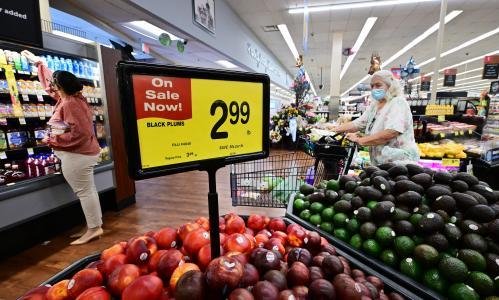
Lauren Aratani
April 12, 2023
US annual inflation reduced to 5% last month, official figures reveal, the slowest pace for price increases since 2021 they first began to climb.
March’s monthly consumer price index (CPI), which measures the price of a basket of goods and services, showed the rate easing off over the last year. In February , the annual inflation figure stood at 6%, already a steep decline from its peak of 9.1% in June.

_1af28fcf1fb19e6654fed3f9dd84fd29854085fb_83_0_4633_2783_500.jpg
But core inflation, which does not include volatile energy and food prices, has remained steady – a sign that the slowing pace could be attributed to comparisons against soaring gas prices a year ago, near the beginning of Russia’s invasion of Ukraine. March’s core inflation rate over the last year was 5.6%, compared with February’s 5.5%.
Housing is the largest contributing factor to price increases over the last few months, rising 0.4% over the last month with an 8.2% rise over the last year. The uptick in housing prices offsets the impact that decreasing energy prices, which went down 6.4% over the last year, have had on the overall inflation rate. Food prices remained stable in March, with no changes over the last month.
Despite the overall cooling, the closely watched inflation report will probably not sway officials at the Federal Reserve, who have been eyeing further interest rate hikes in their aggressive campaign to lower inflation.
Even as the overall inflation rate is on a downward trend, economists are expecting the Fed to continue raising interest rates, despite the volatility increased rates could bring to the economy. In March, the Fed increased rates by a quarter point to a range of 4.75% to 5%, a move largely seen as both assertive and conciliatory in the direct aftermath of the collapse of Silicon Valley Bank (SVB). The Fed has increased interest rates nine consecutive times over the last year, raising rates by a quarter point up to three-quarter points at a time.
In March, the Fed chair, Jerome Powell, said that the central bank was closely monitoring the impact of SVB’s collapse but was still adamant on getting inflation down to a target goal of 2%.
“We’re looking at what’s happening among the banks and asking: ‘Is there going to be some tightening in credit conditions?’ And then we’re thinking about that as effectively doing the same thing that rate hikes do. So in a way, that substitutes for rate hikes,” Powell said. “At the end of the day, we will do enough to bring inflation down to 2%. No one should doubt that.”
In addition to March’s CPI data showing stubborn core inflation, the jobs report from last month also showed signs of continued jobs increases, another key data point the Fed uses to determine interest rate increase.
The labor market added 236,000 jobs in March that, while still an overall increase, shows a slight cooling off of the market. The unemployment rate dropped 0.1% and stands at 3.5%. The data shows that the jobs market is slowing at a measured pace, something the Fed will probably see as a sign that the economy can handle future interest rate hikes, even as concerns over a recession loom.
The Fed will have its next board meeting, where it will announce any upcoming interest rate increase, on 2 May and 3 May.


